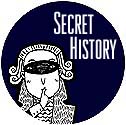
Comment
on this story |
 |

A pilgrimage to a little-known soft-drink shrine
by Jack Neely
You'll have to forgive me if my typing's a little jumpy today. I just drank a whole Mountain Dew, my first in years. I may have gotten a little extra kick from it by drinking it in the building in East Knoxville where Mountain Dew was sort of invented, over 50 years ago.
I drank Mountain Dew some when I was a kid. Because it was translucent, I thought, it couldn't have caffeine in it. But then, I'd drink it and feel funny, and convince myself I was going crazy and about to die. I kicked it cold turkey about the time they took the hillbilly off the label and started embarrassing the hippie market with new slogans like "Hello, Sunshine" and "That Barefoot Feeling."
Anyway, a few days ago reader Jim Reca sent in something I didn't expect, a clipping from the Chicago Sun-Times. A feature by entertainment writer Dave Hoekstra appeared in a Sunday travel section about a month ago. The article's really about a soda-pop museum near Nashville, but what caught Jim's attention, and mine, was Hoekstra's personal aside at the end, where he rhapsodizes about his own favorite soft drink, Mountain Dew.
"Mountain Dew dates back to the early 1940s," writes Hoekstra, "when brothers Ally and Barney Hartman of Knoxville, Tenn., were bottling a 7-Up type brew as their own mixer for hard liquor."
I didn't know that. The original Mountain Dew bottles, Hoekstra continues, had labels adorned with a gun-toting hillbilly and a signature: "By Barney and Ally."
You might think they were a couple of gun-toting hillbillies themselves. But "Ally" was, more properly, Aloysius Hartman, a good Catholic boy who moved here from Quincy, Illinois, in 1931, when he was about 30. He and his older and larger brother Bernard, a well-known golfer hereabouts, established the Hartman Bottling Company, which started out making Orange Crush, and in 1933 unloaded Knoxville's first batch of legal beer, sold it on a railroad siding at the midnight that prohibition ended. In 1935, they became Knoxville's Pepsi bottler. Their building was on the 1900 block of Magnolia, just past Bertrand on the left.
Hartman didn't bottle anything like Seven-Up, which was a popular mixer, even though liquor was still illegal in Knoxville. Aloysius Hartman could see the appeal.
His son, Bernard, now a semi-retired jewelry dealer on Deane Hill, was a kid during those fateful days. He remembers his father as a mild mannered man, just the opposite of his older brother Bernard, whom they called Barney. "Uncle Barney, he was the hard charger, a two-fisted Scotch drinker," Hartman recalls. "He'd tell you where to go and how to get there.
"Mountain Dew originally was a mixer," he confirms. "A Seven-Up type drink, a 'lithiated lemon,' we called it." The Hartmans mixed up a batch of it and conferred with some newspaper advertising folks. "They came up with a logo of a mountaineer with a long rifle, an outhouse, and a pig. And they called it "Mountain Dew."
Of course, Mountain Dew was another name for moonshine. It was even in a great old banjo song, "That good old mountain dew." The name was still free, though, and the Hartman brothers got it copyrighted.
In 1946, they debuted the new soft drink, a clear, dry, uncaffeinated lemony beverage which came in seven-ounce bottles, in the quaint Smoky Mountain retreat, Gatlinburg.
The aggressive Barney Hartman died suddenly of a heart ailment in 1949. Aloysius Hartman stayed in charge of the Hartman Bottling Co., but in the mid-'50s, gave up on Mountain Dew. It was expensive to make, and distributors weren't exactly jumping at it.
"Ally" Hartman offered the franchise to his son. "But I was a 19-year-old kid," he says. "I didn't have money for something like that." The elder Hartman sold the concept to a Marion, Va., bottler named Bill Jones for $1,500. Jones played around with the formula, adding caffeine, a fruitier taste and a green tint. He came out with his own version of Mountain Dew in 1961. (Bernard Hartman admits he likes the reformulated Mountain Dew all right, but says he prefers Diet Pepsi.)
Meanwhile, Aloysius Hartman, unable to expand his growing business further on Magnolia, moved to a much larger, more modern plant on Middlebrook in 1964—the same year, incidentally, that Pepsi acquired Mountain Dew from Bill Jones.
Mountain Dew had become a major national brand by 1970, the year Aloysius Hartman was killed on Liberty Street when his car was hit by a train. Obituaries didn't mention his role in the birth of Mountain Dew.
Today, the conceptual birthplace of Mountain Dew is just down the sidewalk from Mary's Tamales. It's a battered old white-painted brick building with orange letters announcing its current business: Custom Doors and Windows. I barged in and found owner David McWilliams working in the back. He's been here about five years and fashions all kinds of doors, interior, exterior, plus windows and skylights to order. His doors are stacked and leaning all over his large loading area, open to the sunny service alley in the back.
McWilliams knew his building had once been a bottling factory—he can point to the walls where you can see there's been remodeling over the decades—but he'd never heard it connected to the origin of Mountain Dew. He seemed interested in that detail.
I asked David if he liked Mountain Dew. "Sure do," he said. "In fact, I've got some in the refrigerator. Want one?" I gratefully accepted a can from one of his six packs, and took a long, satisfying swig of the stuff in the place where it was conceived. It tickled my innards, sure enough.

September 28, 2000 * Vol. 10, No. 39
© 2000 Metro Pulse
|





